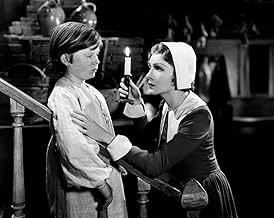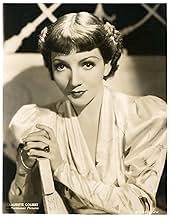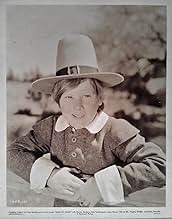Adicionar um enredo no seu idiomaYoung lovers fall afoul of repressive society as Salem elders get caught up in the witch hunts and trials of 17th-century Massachusetts. One family in particular uses the hysteria to its adv... Ler tudoYoung lovers fall afoul of repressive society as Salem elders get caught up in the witch hunts and trials of 17th-century Massachusetts. One family in particular uses the hysteria to its advantage, getting even with everyone for every slight--real or imagined.Young lovers fall afoul of repressive society as Salem elders get caught up in the witch hunts and trials of 17th-century Massachusetts. One family in particular uses the hysteria to its advantage, getting even with everyone for every slight--real or imagined.
- Timothy - Her Son
- (as Bennie Bartlett)
Enredo
Você sabia?
- CuriosidadesFinal film of both Louise Dresser and Lucy Beaumont.
- Citações
Rev. Parris: Speaking of Satan, I also you bid ye beware the frivolity and foolishness of women that bedeck themselves with ribbons, curls and lace bonnets, thus causing the minds of men to, to wander. I tell you that a female that will fritter away her time, trimming and tricking herself out in such a fashion, should be looked upon as the mere gizzard of a trifle . The mere epitome of nothing and a very apt prey for the Devil.
- ConexõesFeatured in Discovering Film: Claudette Colbert (2015)
- Trilhas sonorasBid Me But Live
(uncredited)
Traditional
The script has a mix of characters – some fictitious and others closely resembling real people of the time. Colbert plays Barbara Clarke and MacMurray is Roger Coverman of Virginia. Both are good in their roles, but a number of other characters have as much screen time. The screenplay is choppy in places, the directing is not very strong, and the editing is weak. The cinematography and other production qualities are not very good.
For all its weaker attributes, "Maid of Salem" has some value in the story of a frightening and dark period in early New England history. The Salem witch trials were the American counterpart of the lengthy witch-hunt in Europe. That reached its peak between 1580 and 1630 during the European wars of religion. In America, the preaching and writings of New England Puritan minister Cotton Mather (1663-1728), held much sway with the highly superstitious colonies of Massachusetts. Mather was not directly involved, but is generally considered the source that aroused the fear and fervor that led to the frantic witch-hunts and trials.
I recall a visit in the mid-1990s to Massachusetts. I toured the area so rich in history -- Boston, Concord, Lexington, Salem and the homes of famous authors – Ralph Waldo Emerson and Nathaniel Hawthorne. At Salem I walked through the House of the Seven Gables – the subject of a Hawthorne novel by the same name. It was not far from the Charter Street Cemetery. The oldest cemetery in Salem is near the Commons and the Salem Witch Museum. I read some of the headstones with their simple, short epitaphs that included 12 women and six men who were executed for witchcraft. Here was Rebecca Nurse, hanged on July 19, 1692; and there was Margaret Scott, hanged Sept. 22, 1692. In another place was Bridget Bishop, hanged June 1, 1692; and nearby was Giles Correy, pressed to death on Sept. 19, 1692. John Proctor and Martha Carrier were hanged on Aug. 19, 1692. Samuel Wardwell and Mary Easty were hanged on Sept. 22, 1692.
Also buried there is Ann Putnam (1679-1716), who was the leader of a group of young girls whose accusations led to the frenzy and witch trials. The girl, who then was 13 years old, claimed to be afflicted and she testified against several defendants in court. Years later, she made a public apology for her role in the trials. Of course, her apology fell on the deaf ears of several people whom she led to the grave. Putnam died at age 37 and is buried with her parents in an unmarked grave. Bonita Granville plays the character, Ann, in "Maid of Salem," and gives the best performance of the movie.
Author Nathaniel Hawthorne's great-great-grandfather is buried in the early Salem cemetery. John Hathorne (sic) died May 10, 1717. He was one of the two magistrates who presided over the pre-trial examinations in Salem Village. These took place before the actual witch trials, and two actors play these roles in the movie. In the film, the names are fictitious, but they are based on real persons.
The source of this specific story and screenplay is almost as intriguing as the subject matter. Bradley King was the pen name of Josephine McLaughlin, born in Chicago on July 8, 1894. She was a successful screenwriter who wrote 56 scripts for films between 1920 and 1947. She was married several times. One was a short marriage to silent film director John Griffith. After a later husband, George Hiram Boyd, lost most of her $400,000 fortune to bad investments, she divorced him in 1940. She wrote her last screenplay for the 1947 movie, "That's My Man," and disappeared at age 53. She had been having poor health. She was never heard from again, and there's no known record of her death. All but one of her 40 silent films are lost, but most of her 20 or so sound films still exist. Her 1923 silent film, "Anna Christie" starred Blanche Sweet and is still extant. But, that film is little remembered since the 1930 remake that starred Greta Garbo.
I wonder if King-McLaughlin had any friends who might have tracked her down, or reported her to the police as missing.
- SimonJack
- 30 de out. de 2014
- Link permanente
Principais escolhas
Detalhes
- Tempo de duração1 hora 26 minutos
- Cor
- Proporção
- 1.37 : 1
Contribua para esta página



























